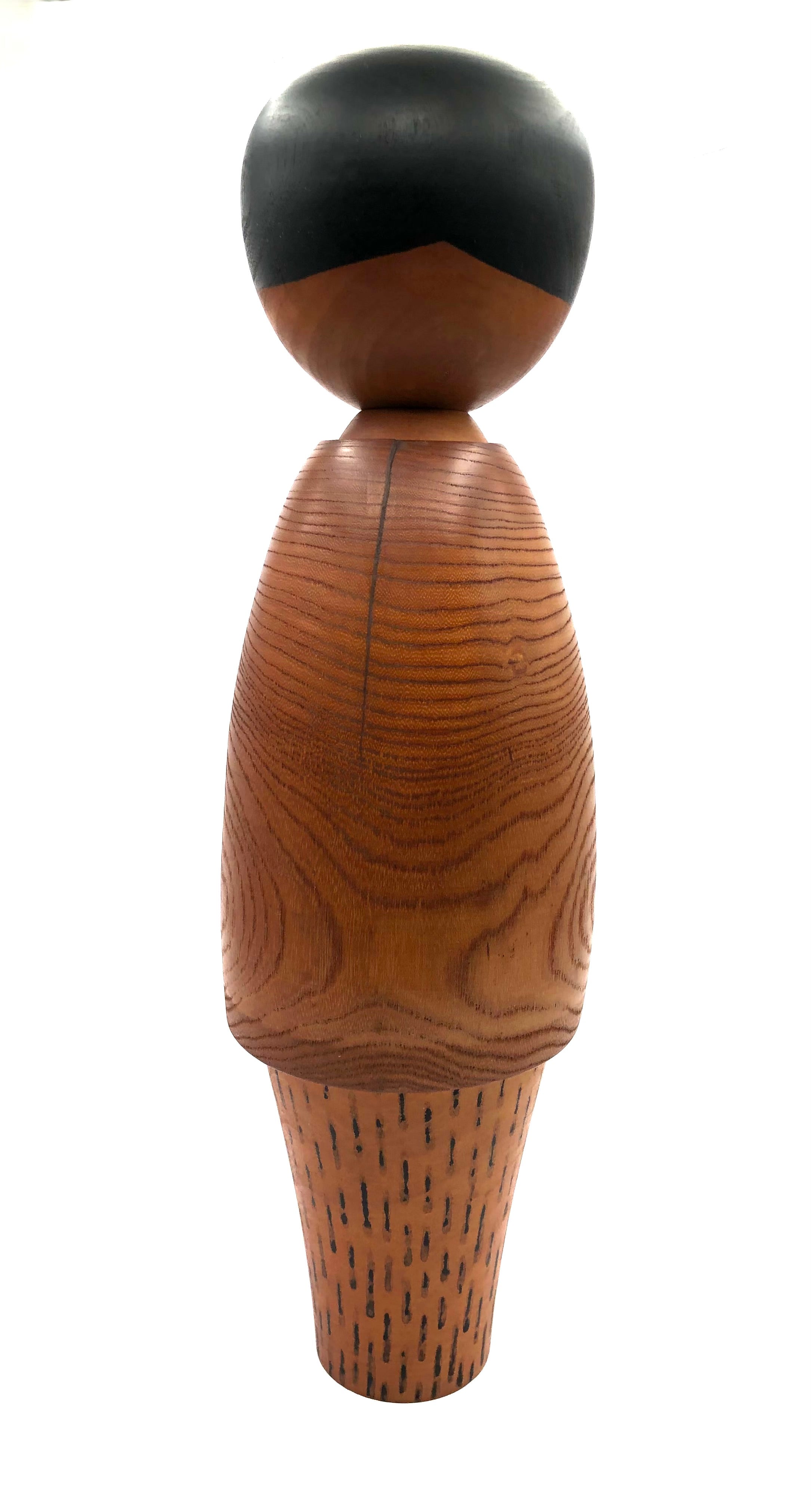




Vintage Sosaku Kokeshi entitled “Take no tome | Bamboo Maiden” by Watanabe, Masao (1917-2007)
Dimensions: 11-0” h
This exceptional doll is a Kokeshi to cherish. Because of its complicated design, construction, and use of different woods to portray the correct impression it i very Rare! We were told by the studio when we purchased this doll that Watanabe-san repaired the piece for he could not see a prized piece of woodworking abandoned. Typically, Japanese craftsmen had no problem in mending areas of breakage related to their works of art, for the Japanese craftsmen treat broken or split wood as part of the history of an object, rather than something to disguise. It is a form of Wabi-sabi which is finding beauty in things imperfect. Wabi-sabi proudly exhibits the effects of accident, like a crack in a wood surface as with this piece. In the pottery and woodworking world, this is known as a form of Tsugi (to put together more strongly). This Kokeshi was purchased at the Watanabe studio and we had to ask to see it for it for it was not featured as if it were for sale.
This beautiful doll not only emphasizes a combination of wood from which it is made — Pear, (Nashi), and Bamboo, (Take), but also the painted portions of the green obi with a tied obijime cord, and the lower portions of the Kimono, which has vertical line work in brown. The most unusual and separate element is the detached jacket (Haori), which moves freely from the doll, emphasizing the wood grain, (this is the part of the doll that has a repair to the upper portion of the jacket, and not through the entire jacket, which has a thin crack in the wood. The jacket closure is made from bamboo and made to look like an odoshi (cord or strap). And, last but not least, is her beautiful serene face with downturned slanted eyes, an implied nose and mouth, and hair treatment with bangs falling over the forehead, all being typical of Watanabe-san dolls. A script signature and the impressed stamp identify Watanabe-san as the artist.
The piece was published in the 2022 publication of Sosaku Kokeshi: Celebrating the Major Artists of the Creative Movement. For more information on this artist go to the following link:https://mingeiarts.com/collections/artisan-woodworker-watanabe-masao-1917-2007.
Condition: Very Good, to Excellent lathe-turned-creation. A visual-tactile experience for it is outstanding, excellent, impressive, and beautiful without chips, or missing pieces, with small artist repair,(see back view image), and retains its original details and finish. The piece meets all the standards of the vintage collectible Sosaku Kokeshi by Watanabe, Masao.

Artisan
Woodworker: Watanabe, Masao
1917-2007
Biographical History:
Watanabe-san is considered to be one of the greatest Sosaku Kokeshi artists in all of Japan. Born in Fukushima, Watanabe-san studied under Traditional Yajirou Master Sato, Tatsuo of Miyagi Prefecture. Arguably, the most popular and prolific of the 20th/c Sosaku Kokeshi artists, he began his craft in the early 1950s. His most famous Kokeshi themes are that of ‘innocence’ (Mushin), and his doll entitled: Chigo Zakura (Cherry Blossom Child) won the Minister’s Award and was presented to the Beatles in 1965, after their appearance in Japan with Sir Joseph Lockwood, Chairman of EMI Record Distributors, England. A multiple award winner from 1963-1981 in Kokeshi competitions around the world (Prime Minister's prizes for the works of "Chigozskura" in 1963 and "Shojo" in 1981), along with numerous prizes by the Modern Kokeshi Artist Association and JETRO. He held two exhibitions in Japan and was exempt from the examination of the All Japan Kokeshi Contest, a Member of the Nippon Kokeshi Artistic Handicraft Association. His works are permanently exhibited at the Nuremberg Toy Museum in Germany.

Collector's note – descriptive qualities, standard characteristics & ornamentation styles:
Of all the Kokeshi the emphasis is on the color of the natural wood and texture, and his diversity of form is the most recognizable characteristic of his dolls. The representation of clothing is seen in the use of the diverse rendering of Kimono, Yukata, and Haori complemented by the painted details that are common throughout his works. Several dolls not only show wonderful color rendition as well as textured/ raised applications resembling Shibori, a type of tie-dyeing that gives texture to the garment. He also prominently features the rose and camellia as a central motif along with extremely expressive eyes throughout the range of ages represented in his works.
Signature Research:
We heard from our colleague at Soulportals KokeshiVillage, a website researching vintage and contemporary Kokeshi artists and signatures. It was brought to our attention that Watanabe subcontracted an artist named Sato Norio to reproduce large numbers of his Kokeshi in the 1960s because of an enormous number of orders for his award-winning design Chigazokaura. Watanabe's signature for pieces designed and crafted by him is shown on this page celebrating a number of his award-winning dolls. Nario's versions were entitled Plum Grove and approved/attributed to Masao but not crafted by him.
Explore & Learn More about Woodworker: Watanabe, Masao